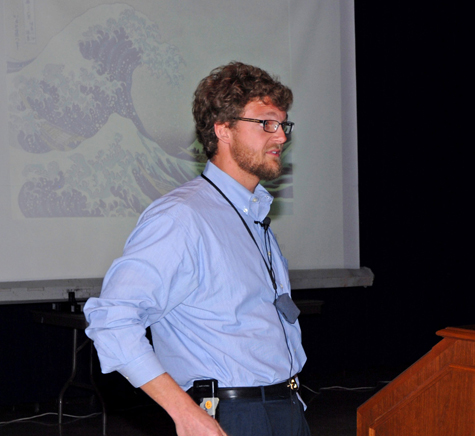VGCC Instructor discusses “misbehaved” waves

A Vance-Granville Community College Spanish instructor raised questions about how we react to the worst that nature has to offer, in the third of four lectures from the college’s Arts and Sciences division under the umbrella title, “Earth’s Energy and Wave Motion: Harmony and Disharmony in Our Relationship with Nature and with Each Other.” Matthew Nielsen’s presentation, called “Tidal Disasters and Mother Nature’s Misbehaved Waves,” was held in the VGCC Civic Center on April 13.
Any natural wave is essentially a force of energy caused by a disturbance, Nielsen told the audience, and in his research on history and culture, he has found that so-called “freak waves” in water have a particularly disturbing psychological effect on people. He included in his discussion storm surges like those seen in hurricanes, tsunamis like the recent storm in Japan, and mysterious “solitons” in oceans that are also called “rogue” waves. “Understanding and learning to coexist with tidal surges, tsunamis, and solitons can cause great discomfort for humans,” Nielsen said. “Certain cultural and scientific explanations and responses have helped to provide some security and peace of mind, yet devastating events continue to challenge humans with the frightening prospect of an extremely energetic and unruly chaos.” Nielsen said that at various times and in various cultures, people have attributed extreme water-related natural disasters to sea monsters and gods. According to a popular Japanese legend, tsunamis were caused by a giant catfish named “Namazu” whose movements along the bottom of the sea caused earthquakes. “Some thought that Namazu worked to put things back into balance when humans behaved badly, so these destructive waves were interpreted as a form of punishment and reformation,” Nielsen said. The instructor wondered why people attempt to avoid recognizing that events like tsunamis are natural occurrences. “Nature is doing the same thing it’s done forever when these things happen,” Nielsen said. “We don’t want to believe that our coasts are unsafe.” Nielsen believes it is “necessary for human populations to readjust their approach to a reasonable coexistence with extreme waves by adjusting popular lifestyles and mindsets rather than simply relying on technology.”
The lecture series concludes on Wednesday, April 27, when music instructor Michael Stephenson discusses “Harmony and Discord in the Music and Personal Lives of the Beatles.” The presentation begins at 1 p.m. in the VGCC Civic Center and is open to the public. For more information on these lectures, call VGCC instructor Joshua McKaughan at (252) 738-3464.
Above: VGCC Spanish instructor Matthew Nielsen discusses human beings’ responses to chaotic “freak waves” during his April 13 lecture in the VGCC Civic Center. (VGCC photo)

